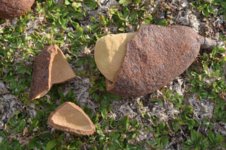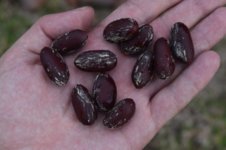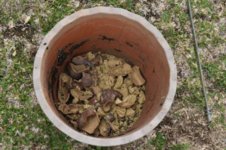Tutu
Well-Known Member
I've always enjoyed planting things, especially trees grown from seed. I think it's remarkable to watch the whole process. Most of the trees I've planted around here are fruit trees, not very rare to their environment. However, there's one species I'm planting that deserves a bit more attention. It is a truly remarkable tree. Although it may not provide for the table in the short run, the pulp of it's seed pods is edible, so it might, eventually. That's not the point though. The idea of planting it is because it's rare.
I'm talking about Hymenaea courbaril.
Now most of the information I've got on this tree is either from the internet or the information board at the sight where I first spotted it. So instead of copy pasting a lot of info on the tree, I'll give a list of links so that you may read a bit about it on the websites first hand. Most of these websites talk about specific trees that can be found in Singapore, which is also where I first spotted the tree. Actually, the one in the Singapore Botanic Gardens is the only one I've ever seen in real life. Another one of these trees should be somewhere around Bury Road. I haven't yet had the time to go there, but I might, the next time I find myself in Singapore. The photos of the tree on the Urban Forest link is the one from which I got my pods.
Wikipedia
Urban Forest
Singapore Flora
National Parks Singapore
St. John's Life
It is said at the description board at the Botanic Gardens that this tree is seldom planted these days, because of the danger from it's falling seedpods. Now the tree in the Gardens is quite dangerous itself. Although it has a safety net hanging over the footpath, I've seen a pod fall through it and crack open on the path. Now these pods are like stone. I wouldn't want to imagine one falling on a passerby. It also says that here were more West Indian Locusts in the Botanic Gardens before. "A famous huge specimen once grew on Lawn H, but was destroyed by repeated lightening strikes before the days when we installed copper cables to protect our trees from these electrical discharges". It also says that it is likely that the tree was first introduced to the Gardens for trialing as a timber tree.
The first time I noticed the tree was during a visit to the Botanic Gardens in February 2017. Without thinking much about it I grabbed a few seedpods and brought them with me to Indonesia. I figured that since there are only a few of these trees in Singapore, a country very particular about preservation of certain tree species, there are probably not a lot of these trees in other South East Asian countries. It took a lot of effort to crack open one of the pods. I had eleven seeds, and planted them all. One of them germinated in the space of a few weeks. I kept it going in a pod for a while, and wanted to transplant it a couple of months later. Upon inspection, I saw that a second seed had germinated. This was quite interesting, because it had taken that seeds about six months to do so. So I have planted one in full ground, and another is still in a pot. You'll see pictures below.
A few weeks ago I went to Singapore once more, and went to the Botanic Gardens, of course. So I collected a lot of pods and brought them home. The pods I got this time seemed freshly fallen of the tree, so I suspect the seeds to be slightly more viable than last time. I've already crushed a few pods and planted the seeds. I took pictures of it, so I could show it to you guys. By the way, the pulp tastes delicious, but it's very sticky once it gets wet and difficult to rinse it from your mouth. The smell of the pods is indeed a bit unpleasant.
Another very interesting tree species, similar to this one, is Couroupita guianensis, or the Cannonball Tree. It can be found in the Botanic Gardens, as well as in Fort Canning Park. I hope to be able to bring home some of its seeds in the future.
It really excites me to bring rare seeds home and plant them. No idea if the little fellow will survive. The soil here isn't that great. It's just a small layer of soil and then a lot of rubble under it. I've dug up some of the stones and rocks around the place were I planted the tree. It may help it settle a little bit.







I'm talking about Hymenaea courbaril.
Now most of the information I've got on this tree is either from the internet or the information board at the sight where I first spotted it. So instead of copy pasting a lot of info on the tree, I'll give a list of links so that you may read a bit about it on the websites first hand. Most of these websites talk about specific trees that can be found in Singapore, which is also where I first spotted the tree. Actually, the one in the Singapore Botanic Gardens is the only one I've ever seen in real life. Another one of these trees should be somewhere around Bury Road. I haven't yet had the time to go there, but I might, the next time I find myself in Singapore. The photos of the tree on the Urban Forest link is the one from which I got my pods.
Wikipedia
Urban Forest
Singapore Flora
National Parks Singapore
St. John's Life
It is said at the description board at the Botanic Gardens that this tree is seldom planted these days, because of the danger from it's falling seedpods. Now the tree in the Gardens is quite dangerous itself. Although it has a safety net hanging over the footpath, I've seen a pod fall through it and crack open on the path. Now these pods are like stone. I wouldn't want to imagine one falling on a passerby. It also says that here were more West Indian Locusts in the Botanic Gardens before. "A famous huge specimen once grew on Lawn H, but was destroyed by repeated lightening strikes before the days when we installed copper cables to protect our trees from these electrical discharges". It also says that it is likely that the tree was first introduced to the Gardens for trialing as a timber tree.
The first time I noticed the tree was during a visit to the Botanic Gardens in February 2017. Without thinking much about it I grabbed a few seedpods and brought them with me to Indonesia. I figured that since there are only a few of these trees in Singapore, a country very particular about preservation of certain tree species, there are probably not a lot of these trees in other South East Asian countries. It took a lot of effort to crack open one of the pods. I had eleven seeds, and planted them all. One of them germinated in the space of a few weeks. I kept it going in a pod for a while, and wanted to transplant it a couple of months later. Upon inspection, I saw that a second seed had germinated. This was quite interesting, because it had taken that seeds about six months to do so. So I have planted one in full ground, and another is still in a pot. You'll see pictures below.
A few weeks ago I went to Singapore once more, and went to the Botanic Gardens, of course. So I collected a lot of pods and brought them home. The pods I got this time seemed freshly fallen of the tree, so I suspect the seeds to be slightly more viable than last time. I've already crushed a few pods and planted the seeds. I took pictures of it, so I could show it to you guys. By the way, the pulp tastes delicious, but it's very sticky once it gets wet and difficult to rinse it from your mouth. The smell of the pods is indeed a bit unpleasant.
Another very interesting tree species, similar to this one, is Couroupita guianensis, or the Cannonball Tree. It can be found in the Botanic Gardens, as well as in Fort Canning Park. I hope to be able to bring home some of its seeds in the future.
It really excites me to bring rare seeds home and plant them. No idea if the little fellow will survive. The soil here isn't that great. It's just a small layer of soil and then a lot of rubble under it. I've dug up some of the stones and rocks around the place were I planted the tree. It may help it settle a little bit.








